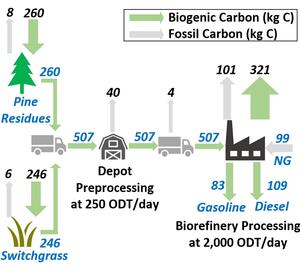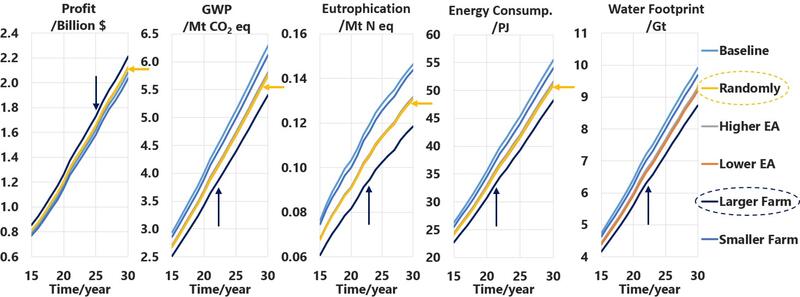Bioenergy is widely regarded as sustainable alternatives to fossil fuels. Our group develops systems analysis tools to understand the environmental and economic implications of producing and using bioenergy. We seek synergetic opportunities to optimize biomass cultivation and bioenergy production simultaneously.
Impacts of Biomass Quality on the Econoimc Feasbility of Biofuels
Lan, K., Park, S., Kelley, S., English, B., Yu, E., Larson, J. and Y. Yao
* (2020). Understanding the Effects of Feedstock Quality Uncertainties on the Economic Feasibilities of Fast Pyrolysis Biorefineries with Blended Feedstocks and Decentralized Preprocessing Sites in the Southeastern United States. GCB Bioenergy.
https://doi.org/10.1111/gcbb.12752.
Blending Biomass for Robust Bioenergy Supply Chain

Blending biomass feedstock is a promising approach to mitigate supply chain risks that are common challenges for large-scale biomass utilization. We developed a cradle-to-gate life cycle analysis model for fast pyrolysis biorefineries converting blended feedstocks (pine residues and switchgrass) with traditional centralized and alternative decentralized preprocessing sites, so-called depots. The life-cycle energy consumption and Global Warming Potentials (GWP) of biofuel production with depots varied between 0.7-1.1 MJ/MJ and 43.2-76.6 g CO2 eq./MJ, respectively. The differing results are driven by both the biorefinery processes and depot preprocesses. Decentralized design reduces the energy consumption of biorefinery, but increases overall life-cycle energy and GWP. Such increases could be significantly mitigated by increasing switchgrass content as the energy consumption at depot is driven in large part by the higher moisture content of pine feedstocks.
Lan, K., Ou, L., Park, S., Kelley, SS. and Y. Yao* (2019). Life Cycle Assessment of Decentralized Preprocessing Systems for Fast Pyrolysis Biorefineries with Blended Feedstocks in the Southeastern United States. Energy Technology.
Sustainable Management for Biomass Cultivation
As food demand increases, it is critical to develop effective strategies and evaluate their potential in reducing greenhouse gas (GHG) emissions and other environmental footprints of agricultural systems that consist of a large number of farms. This study addresses the challenge by developing a dynamic system-modeling framework integrating Life Cycle Assessment (LCA), Agent-Based Modeling (ABM), and Techno-Economic Analysis (TEA). LCA and TEA are coupled with dynamic simulation models of crop yields, costs, and prices, allowing for the estimation of life-cycle environmental impacts and profitability of crop planting activities under changing climate and economic conditions. The framework was demonstrated by a case study for an agricultural system, including 1,000 farms in the United States over a 30-year time frame. The results indicated that information exchange among farmers, farmers’ environmental awareness, access to environmental footprint information, and farm size are key factors driving the system’s environmental impacts. The results can provide a broad range of stakeholders (e.g., policymakers, nonprofits, agriculture companies) with insightful information to tailor their strategies for effectively managing the environmental footprints of large-scale agricultural systems. The integrated modeling framework has the potential to address sustainability challenges in other systems that are dynamic, involve human behaviors, and have complex interactions among human and nature systems.


